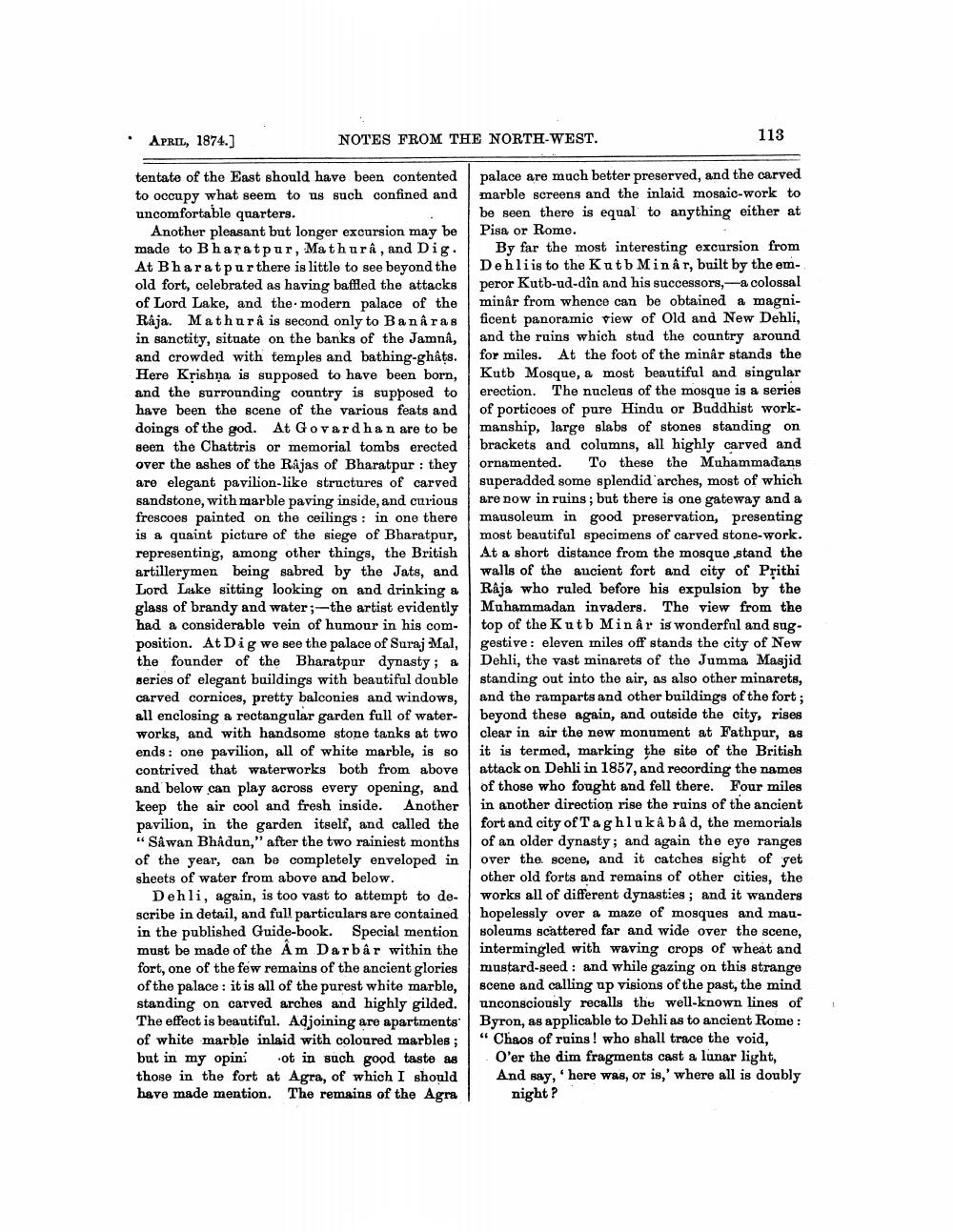________________
NOTES FROM THE NORTH-WEST.
APRIL, 1874.]
tentate of the East should have been contented to occupy what seem to us such confined and uncomfortable quarters.
Another pleasant but longer excursion may be made to Bharatpur, Mathurâ, and Dig. At Bharatpur there is little to see beyond the old fort, celebrated as having baffled the attacks of Lord Lake, and the modern palace of the Rája. Mathur â is second only to Banaras in sanctity, situate on the banks of the Jamnâ, and crowded with temples and bathing-ghâts. Here Krishna is supposed to have been born, and the surrounding country is supposed to have been the scene of the various feats and doings of the god. At Govardhan are to be seen the Chattris or memorial tombs erected over the ashes of the Rajas of Bharatpur : they are elegant pavilion-like structures of carved sandstone, with marble paving inside, and curious frescoes painted on the ceilings in one there is a quaint picture of the siege of Bharatpur, representing, among other things, the British artillerymen being sabred by the Jats, and Lord Lake sitting looking on and drinking a glass of brandy and water;-the artist evidently had a considerable vein of humour in his con composition. At Dig we see the palace of Suraj Mal, the founder of the Bharatpur dynasty; a series of elegant buildings with beautiful double carved cornices, pretty balconies and windows, all enclosing a rectangular garden full of waterworks, and with handsome stone tanks at two ends: one pavilion, all of white marble, is so contrived that waterworks both from above. and below can play across every opening, and keep the air cool and fresh inside. Another pavilion, in the garden itself, and called the "Sawan Bhâdun," after the two rainiest months of the year, can be completely enveloped in sheets of water from above and below.
Dehli, again, is too vast to attempt to describe in detail, and full particulars are contained in the published Guide-book. Special mention must be made of the Am Darbar within the fort, one of the few remains of the ancient glories of the palace: it is all of the purest white marble, standing on carved arches and highly gilded. The effect is beautiful. Adjoining are apartments of white marble inlaid with coloured marbles; but in my opini ot in such good taste as those in the fort at Agra, of which I should have made mention. The remains of the Agra
113
palace are much better preserved, and the carved marble screens and the inlaid mosaic-work to be seen there is equal to anything either at Pisa or Rome.
By far the most interesting excursion from Dehliis to the Kutb Minar, built by the emperor Kutb-ud-din and his successors, a colossal minâr from whence can be obtained a magnificent panoramic view of Old and New Dehli, and the ruins which stud the country around for miles. At the foot of the minâr stands the Kutb Mosque, a most beautiful and singular erection. The nucleus of the mosque is a series of porticoes of pure Hindu or Buddhist workmanship, large slabs of stones standing on brackets and columns, all highly carved and ornamented. To these the Muhammadans superadded some splendid arches, most of which are now in ruins; but there is one gateway and a mausoleum in good preservation, presenting most beautiful specimens of carved stone-work. At a short distance from the mosque stand the walls of the ancient fort and city of Prithi Raja who ruled before his expulsion by the Muhammadan invaders. The view from the top of the Kutb Minâr is wonderful and suggestive: eleven miles off stands the city of New Dehli, the vast minarets of the Jumma Masjid standing out into the air, as also other minarets, and the ramparts and other buildings of the fort; beyond these again, and outside the city, rises clear in air the new monument at Fathpur, as it is termed, marking the site of the British attack on Dehli in 1857, and recording the names of those who fought and fell there. Four miles in another direction rise the ruins of the ancient fort and city of Taghlukâbâd, the memorials of an older dynasty; and again the eye ranges over the scene, and it catches sight of yet other old forts and remains of other cities, the works all of different dynasties; and it wanders hopelessly over a maze of mosques and mausoleums scattered far and wide over the scene, intermingled with waving crops of wheat and mustard-seed and while gazing on this strange scene and calling up visions of the past, the mind unconsciously recalls the well-known lines of Byron, as applicable to Dehli as to ancient Rome: "Chaos of ruins! who shall trace the void,
O'er the dim fragments cast a lunar light, And say, 'here was, or is,' where all is doubly night ?




